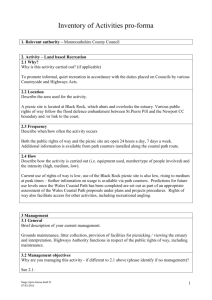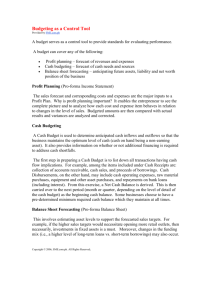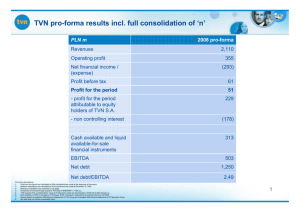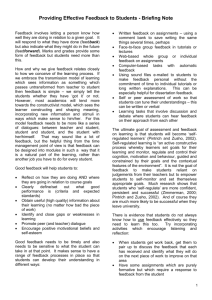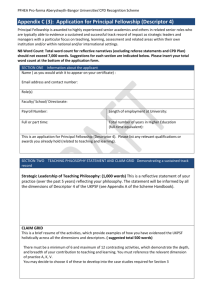Proforma policy - Pace University
advertisement
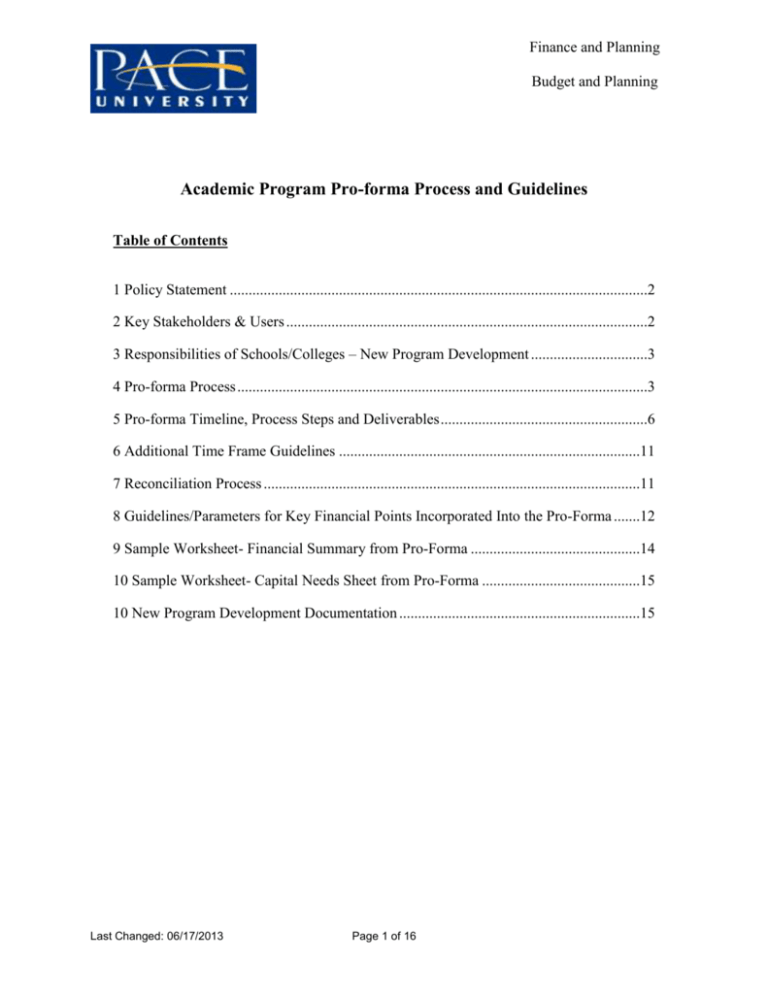
Finance and Planning Budget and Planning Academic Program Pro-forma Process and Guidelines Table of Contents 1 Policy Statement ...............................................................................................................2 2 Key Stakeholders & Users ................................................................................................2 3 Responsibilities of Schools/Colleges – New Program Development ...............................3 4 Pro-forma Process .............................................................................................................3 5 Pro-forma Timeline, Process Steps and Deliverables .......................................................6 6 Additional Time Frame Guidelines ................................................................................11 7 Reconciliation Process ....................................................................................................11 8 Guidelines/Parameters for Key Financial Points Incorporated Into the Pro-Forma .......12 9 Sample Worksheet- Financial Summary from Pro-Forma .............................................14 10 Sample Worksheet- Capital Needs Sheet from Pro-Forma ..........................................15 10 New Program Development Documentation ................................................................15 Last Changed: 06/17/2013 1 Page 1 of 16 Finance and Planning Budget and Planning 1 Policy Statement New program development is an important component of our commitment to being a student centered university; it ensures that we are focused on the changing needs of our students. In order to facilitate this process the Provost Office has a site dedicated to the guidelines and steps that are required to develop a new program. In this document we are addressing the Pro-forma process step (3). Provost New Program Development Website link: http://www.pace.edu/provost/sites/pace.edu.provost/files/files/Guidelines%20for%20%20 Program%20Development.doc 2 Key Stakeholders & Users The primary stakeholders as represented by departments and positions include: Department Primary Stakeholders Provost’s Office Schools/Colleges Finance & Planning Enrollment Management Secondary Stakeholders Finance & Planning Administration Enrollment Management & Financial Aid Provost’s Office Office for Student Assistance (OSA) Other support groups Last Changed: 06/17/2013 2 Page 2 of 16 Position Provost AVP-Academic Finance Deans Program Directors Budget Reps AVP of Budget and Planning Budget Directors VP for Enrollment Management and Financial Aid CFO Treasurer Controller SVP, Office of Administration Budget Director for Administration Dean for Admissions Financial Aid Director Associate Provost for Academic Affairs AVP for OSA Tangential ones: Student Success, Student Affairs, CTLT, Library, ITS, etc. Finance and Planning Budget and Planning 3 Responsibilities of Schools/Colleges – New Program Development Deans: Deans have the overall responsibility to oversee program development for their respective school/college. Although there is some shared responsibility for recruiting students with Enrollment Management, Deans are ultimately accountable for the program’s success and meeting the targets incorporated in pro-formas. Individual program pro-formas should state to what degree EM and the school/college will carry out and own the recruiting. Program Directors: The program director is the DRI (Direct Responsible Individual, as designated by the Dean) for the pro-forma and plays an active ownership role in program development. The program director is responsible for evaluating a program's resource needs and determining revenue and cost projections through the process with the assistance of the budget rep. The program director serves as the default point-of-contact for the program (unless otherwise indicated in the form) and should present the pro-forma to the Committee. Budget Representative: Budget representatives are a key end user of this process, on behalf of their Dean and the program directors. The budget rep is responsible for explaining the pro-forma form and navigating the pro-forma process for the pro-forma's DRI. The budget rep typically helps to gather/identify the financial information to translate into the pro-forma. Once the pro-forma is approved, implementation of the program will begin which may include capital projects. The DRI for the program during this stage should be noted in the pro-forma form to be the point-of-contact for the project. The program director ishte default, unless a specific person is identified. 4 Pro-forma Process Development: The respective school/college should have formalized meetings with supporting departments early in the development process. If capital is involved in the new program, meetings with Administration need to occur as well. These departments will advise and guide the programs. Their feedback (issues, risks and recommendations) will be captured in the supporting document and included in pro-forma so that feedback is clear and transparent to all parties. The school/college would then have the opportunity to communicate how the feedback was considered and explain why/why not it was incorporated into the pro-forma through the review process and ultimately to the Review Committee. a. Enrollment Management/Admissions: This meeting serves to crystallize the program’s offering and market viability, determine enrollment estimates, and Last Changed: 06/17/2013 3 Page 3 of 16 Finance and Planning Budget and Planning develop a marketing/recruiting plan. The program should use and complete the “New Program Business Case Proposal” template which guides the type of information and analysis that should be produced by the program for the initial meeting with EM. Consultation with Enrollment Management ensures that headcount projections are realistic and should represent the actual number of students the school/college intends to enroll in the program. The program should be viable in the market and headcount projections should be substantiated by demand. Projections should reflect EM’s knowledge about demand in that field and Pace’s ability to attract students for the program. Enrollment Management would also provide expert advice such as the amount of marketing dollars required to meet headcount goals. The “New Program Business Case Proposal” should be refined and the proforma should be partially complete by the end of the formalized meetings with EM. b. FA/OSA: This meeting helps to educate program developers around the implication of the program’s structure on the financial aid eligibility for the expected student population. Complex programs (in terms of how far they differ from the traditional semester model) require specific support needs and at times dedicated staff. Certain programs and students expect high levels of service or specific needs, which may require dedicate staff. OSA estimates that for every 2 complex programs, it requires a full-time person to handle those needs. FA also dedicates staff for certain programs that are deemed complex. c. Administration: This meeting (with Physical Plant or Information Technology Services) serves to assist programs in developing their space, technology and capital needs. Administration will provide estimates for operating costs. Rough order of magnitude budgets or “ballpark” estimates will be provided for capital projects using information available at that time. Funding sources for capital items will also need to be identified. Capital items under a $50,000 threshold can be funded with departmental funding or the area may request to be included in the capital budget process. Items over the $50,000 threshold will automatically be included in the capital budget process. All capital expenditures require a capital pre-determination. In order to determine if an intended expenditure qualifies for capitalization please refer to the Fixed Assets Policy & Procedure and contact the Associate Controller of Accounting and Reporting in the Finance Department. Last Changed: 06/17/2013 4 Page 4 of 16 Finance and Planning Budget and Planning More complex projects involving a significant amount of capital investment are the exception and will require additional work, planning time, coordination, and oversight. The school/college should present its pro-forma to the committee and defer to the Review Committee for required next steps. Next steps may include hiring a specialized contractor, architect or design consultant or additional work to assist in budget refinement. Initial Pro-Forma approval The AVP of Academic Finance submits all pro-forma’s along with a consolidated proform document to the Budget office for assessment and sign-off. After Budget Office review the AVP of Academic Finance meets with the Provost to review pro-formas for academic standing. As a result of this review, Provost provides approval for the proforma to move forward to the Review Committee. Pro-Forma Review Committee A standing committee, comprised of EM, Finance and Planning, OSA, Financial Aid, Administration and chaired by the Provost’s Office, will evaluate program proposals and pro-formas from a holistic standpoint. The existing Financial Aid Review Committee (FARC) should be utilized as the Committee. Specific meetings would be devoted to proformas in the Fall (October/November). Meetings would focus on a set of materials provided in advance to the Committee. The submitting program would also be invited to attend and answer questions about the program. Committee will provide a recommendation whether or not to approve this program to move forward. Since pro-formas are multi-year, the Review committee will evaluate the 5 years of revenue, operating expense and capital expense. Capital needs would be revised and resubmitted each year through the Capital Approval Process based on the changing needs of the program. It is important that the committee have a multi-year outlook on the proforma, since the operating and capital expenses may be necessary in future years to serve the growth in the students. An approval of the pro-forma implies that the financial projections for the next five years of the program are reasonable. The Committee should treat pro-formas that require major investment from the University as off-cycle projects and advise the program on an individual basis as to the process it should take to complete the pro-forma. These projects are few and far between, but require additional planning time, coordination, and oversight. The Committee may also request additional analysis from the program, including but not limited to: cash/GAAP impact analysis and a “true cost” analysis of the program (which would be in addition to the “incremental” analysis that is the current practice of pro-forma development. Depending on the pro-forma, the Committee may require pro-forma updates when milestones are reached or capital budgets refined during the planning process or on a regular basis until the program is implemented. Final Pro-Forma Approval: Once a program receives Pro- Forma approval from the Review Committee the Provost’s Office must confirm with the Budget Office so that the financials are finalized within the Annual Budget calendar cycle. The approval, in addition to specifying and confirming the Last Changed: 06/17/2013 5 Page 5 of 16 Finance and Planning Budget and Planning revenue and expense budgets within the pro-forma, will be communicated to the Dean and Budget Reps (or other point-of-contact identified in the pro-forma) of each school. If not approved, Provost’s Office and/or Committee will also provide a communication to the school, including specific reasons why the pro-forma was not be approved and providing the opportunity for the college/school to revise and re-present at the next Committee meeting. If approved, The AVP of Academic Finance will notify requesting department that the school should commence the state and faculty approvals processes as necessary. 5 Pro-forma Timeline, Process Steps and Deliverables The process below outlines the components of developing new academic programs. Specific steps within the faculty governance processes, NY State processes, etc. are not fully included except in reference to the pro-forma process. Timeline June/July (or any time prior to this, assuming the program would not start until the next fiscal year) Process Step Related Info Deans (and/or Program Developer) and Budget Reps arrange meeting(s) with Enrollment Management & Admissions Meeting should focus around the program offering, market viability, enrollment targets (for 1st year and outyears or growth rate), etc. The school should also have thought through a financial aid target to be further solidified in this meeting. Budget Office may be consulted during this step for guidance on discount or retention rates Last Changed: 06/17/2013 6 Page 6 of 16 Input or Approval? Input Deliverable or Supporting Materials New Program Business Case Proposal Pro-forma should be partially complete once meeting(s) with EM are over EM should document issues, risks, and recs regarding program “Standard Rates” supporting document will include typical rates (discount, tuition, and retention) that budget reps could reference Finance and Planning Budget and Planning Input or Approval? Timeline Process Step Related Info June/July (or any time prior to this, assuming the program would not start until the next fiscal year) Deans (and/or Program Developer) and Budget Reps arrange meeting(s) with Financial Aid & OSA Meeting should focus on financial aid implications of program, complexity of program, and needs of OSA/FA to administer program Input June/July (Note: If a significant amount of capital is anticipate d, then this entire process must start earlier (Fall or Spring semester) Deans (and/or Program Developer) and Budget Reps arrange meeting with Administration Meeting(s) should define capital needs and “rough order” estimates based on input provided by program Input Last Changed: 06/17/2013 Deliverable or Supporting Materials New Program Business Case Proposal and Proforma (refined as necessary) OSA/FA should document issues, risks, and recs regarding program New Program Business Case Proposal (refined as necessary) Pro-forma updated (specifically Capital tab) ; Should outline capital needs/budget over 5 years and include depreciation Administration should document issues, risks, and recs regarding program 7 Page 7 of 16 Finance and Planning Budget and Planning Timeline Process Step Related Info Input or Approval? Deliverable or Supporting Materials August Deans (and/or Program Developer) and Budget Reps arrange meeting(s) with AVP – Academic Finance; Budget reps revise based on feedback and build a consolidated set of pro-formas for their individual school AVPInput Academic Finance inquires about revenue and cost estimates; Checks for completeness and reasonable assumptions; Provides guidance on issues or open items in proforma Consolidated schoolbased pro-formas (should include issues, recs, and recommendations identified by supporting departments) August AVP-Academic Finance develops consolidated pro-forma across University Input Consolidated university-wide proforma (should include issues, recs, and recommendations identified by supporting departments) August / September AVP – Acad Fin meets with Budget and Planning for initial comments/questi ons This deliverable should be reviewed to understand potential resources needs across schools Budget provides input in terms of issues, risks, and recs; If there is no input to provide, then Budget Office provides signoff that proformas abide by guidelines and are complete Input Budget Office should document issues, risks, and recs regarding program Last Changed: 06/17/2013 8 Page 8 of 16 Finance and Planning Budget and Planning Timeline Process Step September AVP – Acad Fin meets with Provost and follows-up with schools/colleges to update proforma if needed Preliminary Capital approval September Related Info Administratio n, in consultation with Finance, provides prelim capital approval for items over $50K Input or Approval? Input Updated pro-formas Approval Updated pro-formas and communication to the Schools. This deadline is critical for the Budget Office to develop the University Budget Supporting Materials: 1) New Program Business Case Proposal 2) Pro-forma 3) Documented issues, risks, and recs from department meetings September 14th Initial sign-off from Provost Initial Approval October Pro-Forma presented to Review Committee by program for recommendation for approval Rec for Approval Last Changed: 06/17/2013 9 Page 9 of 16 Deliverable or Supporting Materials Finance and Planning Budget and Planning Timeline Process Step Related Info November 1 Recommendatio n / No Recommendatio n for Approval provided to Provost; Provost makes final approval decision If approved: ACADEMIC STEP: Once this occurs, schools/colleg es should proceed with academic approvals (such as faculty governance and State Approval) Input or Approval? Deliverable or Supporting Materials Final Approval* The pro-forma will only be finalized within the Pace University budget once final approval is granted for the pro-forma and once the program receives academic and State Approval *Pro-formas with over $50K of capital requests are approved contingent upon Board of Trustee approval. Pro-formas with under $50K in capital requests are approved to move ahead with an operating funding source. Last Changed: 06/17/2013 10 10 of 16 Page Finance and Planning Budget and Planning 6 Additional Time Frame Guidelines Pro-Formas Submitted in the Spring Semester: Programs will also have the option to submit pro-formas in the spring semester. However, these will be considered for the following budget cycle. This is an option for programs that either miss the fall submission timeframe or would like a head-start in developing a new program. The Review Committee will meet during the spring semester to review these. Additional Process Information Related to NY State: The timeframe to gain approval from NY State is s out of the control of the schools/colleges. While the Review Committee and Provost “approve” pro-formas, this approval is contingent on receiving NY State approval prior to the implementation of the program. When NY State approval comes very late in the year, it becomes increasingly difficult to implement the program due to several factors, such as having enough time to recruit students. Thus, the program must confirm with the Committee once NY State Approval has been received. Committee members can then raise issues as to whether the program should still be implemented for the originally planned semester. Decisions would be made on a program-to-program basis. 7 Reconciliation Process A reconciliation process assures that programs are meeting expectations as outlined. An annual process will be introduced in FY14 for FY13 programs results. 1. Programs with existing pro-formas must report actuals (financials and headcount) against projections. This will be an annual process that occurs after the audit is complete. During the budget development process existing pro-formas should also be updated with adjusted enrollment, revenue, and expense projections for future years based on the current and historical performance of the program. 2. Adjusted enrollment, revenue, and expense projections for future years based on the current and historical performance of the program. For example, if student demand and revenue potential are higher than anticipated for the program, the updated pro-forma would reflect this and the additional expenses that are necessary to fund the growth. Likewise, if revenue targets were deemed unlikely to be met, then the pro-forma would show an expense reduction based on the lower than anticipated headcount. Capital expenses should also be re-evaluated based on the changing needs of the program. This reconciliation should also include GAAP and CASH updates (only if these analysis were warranted by the Committee.) Last Changed: 06/17/2013 11 11 of 16 Page Finance and Planning Budget and Planning Redeploying Resources: The redeployment of resources, such as faculty, should be evaluated for programs that do not meet their targets. These types of steps should be considered in the action plan for programs that do not meet their targets through the reconciliation process. Addition of Resources: Conversely, if the program exceeds expectations it should be evaluated for additional resources. 8 Guidelines/Parameters for Key Financial Points Incorporated Into the Pro-Forma Targets for Margin: As per analysis done using the RCM as a guide, programs should generally produce a 30% - 35% margin. The 35% margin represents the indirect costs of the program and is included in the pro-forma to help support the additional costs of the University. It does not represent a “surplus” to the University. Any margin beyond the 35% will be considered a contribution to the University and will be treated/allocated as Pace’s current practice. Future guidelines around margins should be informed by a more robust understanding of our existing margins at the program level. These should be analyzed going forward and should consider the distinction between incremental and true costs. Overhead and Support Group Costs: For programs that determine that funds are needed to directly support a program from a support group (such as Financial Aid), this should be included directly on the pro-forma and would not be covered by an overhead allocation. o The 35% margin referenced in the “Target for Margins” section would cover overhead and support group costs. Start-Up Funds / Seed money: Start-up funds should be funded from the existing school budget. It is recommended that every school set aside some dollars to have available as a startup fund, since a small start-up fund would be helpful to support the ramp-up of new programs. Some examples for start-up funds include: o Marketing (though there is no “rule-of-thumb” for the amount of marketing dollars that should be built into a pro-forma. It depends on the program and types of collateral needs, other recruiting tactics, etc.) o Faculty o Consultant/Contractor (for complex, large-scale programs that most likely require capital) or other upfront capital investments o Investments such as labs, equipment, etc. Last Changed: 06/17/2013 12 12 of 16 Page Finance and Planning Budget and Planning Contingency: Schools/colleges should include approximately $20K - $30K per program year for contingency purposes. This is a general guideline and could change depending on the program. This should not include any contingency related to capital costs. To ensure their appropriateness, programs could run their use of contingency by the AVP, Academic Finance for confirmation. Faculty: The Provost’s Office, as a general guideline, advises that programs continue with Pace’s traditional approach that existing full-time professors develop and teach a new program, with the help of clinical professors and adjuncts. In the early years, tenuretrack faculty could be incorporated into the pro-forma to help build new programs. Adjunct dollars should also be budgeted to cover the full time teaching hours that will need to be replaced in order to assign an existing professor. Incentives: Implementation of the RCM will provide an incentive structure to schools/colleges to produce financially sound programs. An initial implementation will occur during FY14, during which it will be evaluated and further refined for the following year. Last Changed: 06/17/2013 13 13 of 16 Page Finance and Planning Budget and Planning 9 Sample Worksheet- Financial Summary from Pro-Forma Program Title: School/College: <ABC> <XYZ> Financial Summary, "Milestone-Driven" Planning, and Assumptions Financial Summary 2014 - 2015 2015 - 2016 2016 - 2017 2017 - 2018 2018 - 2019 20 40 60 76 83 Total Students Gross Tuition Revenue Financial Aid Net Tuition Revenue $ $ $ 764,040 $ 419,458 $ 344,582 $ 1,581,257 $ 868,110 $ 713,147 $ 2,480,975 $ 1,362,055 $ 1,118,920 $ 3,250,162 $ 1,784,339 $ 1,465,823 $ 3,726,449 2,045,820 1,680,628 Total Fees Total Other Revenue $ $ 3,600 $ 1,500 $ 7,164 $ 1,500 $ 10,808 $ 1,500 $ 13,614 $ 1,500 $ 15,009 1,500 Total Revenue $ 349,682 $ 721,811 $ 1,131,228 $ 1,480,937 $ 1,697,137 Total Expenses $ (471,380) $ (417,671) $ (439,583) $ (449,793) $ (443,643) Operating Net Operating Margin $ (121,698) $ -35% 304,140 $ 42% 691,645 $ 61% 1,031,144 $ 70% 1,253,495 74% 35% 35% (50,000) $ (60,000) $ Target Margin* 35% Capital $ Net Present Value** $ (200,000) $ 35% 35% - $ - 2,587,901 *The 35% margin represents the program's contribution to overhead costs. It is reasonable that this target would not be met until the third year of the program, giving the program a window of time to ramp up. **This calculation is awaiting input from Finance Milestone-Driven Planning In order for the pro-forma to be more useful as a management tool, some contingency planning should occur within the pro-forma to adjust the program and mitigate the effects of less-than-desirable outcomes (for example, low recruitment.) Pleaes describe in explicit terms the “milestones” that need to be reached in order to incur certain costs. For example, the program could state that a staff member will only be hired in Year 1 if <X> is actualized in headcount or credits. Milestones to be achieved & Mitigating Actions for not achieving targets: Assumptions & Notes Please document the k ey assumptions and other notes below; Feel free to directly include the k ey assumptions already documented within the revenue and expense tabs. Assumptions and other Notes: Last Changed: 06/17/2013 14 14 of 16 Page Finance and Planning Budget and Planning 10 Sample Worksheet- Capital Needs Sheet from Pro-Forma Program Title: <ABC> School/College: <XYZ> Capital Needs Index and/or Account Code Capital Projects 1) 2) 3) 4) 5) 6) 7) 8) 9) 10) (amount shown in first full yr of srvc) Laboratory Renovation Specialized Equipment Depreciation 1) 2) 3) 4) 5) 6) 7) 8) 9) 10) 2014 - 2015 2015 - 2016 2016 - 2017 2017 - 2018 2018 - 2019 $120,000 $0 $80,000 $0 $50,000 $0 $60,000 $0 $0 $200,000 $50,000 $60,000 $0 $0 $0 $104,000 $24,000 $0 $80,000 $40,667 $24,000 $16,667 $0 $52,667 $36,000 $16,667 $0 $52,667 $36,000 $16,667 $0 $36,000 $36,000 $0 $0 $12,000 $12,000 $0 $0 Depr Life 5 3 1 Total Capital Projects 2013 - 2014 Index and/or Account Code Total Depreciation Laboratory Renovation Specialized Equipment Detailed Descriptions, Notes, and Assumptions Please provide detailed descriptions for each capital need, as this assists in capital pre-determination. 11 New Program Development Documentation The following draft documents will be used by the DRI and the Budget Representatives to complete the pro-forma. New Program Business Case Proposal Pro-Forma Documentation o Cover and Approval Summary o Milestones and Assumptions o Issues, Risks and Recommendations o Revenue o Expenses o Capital Needs o Comprehensive Expense List (reference) o Standard Rates (reference) Last Changed: 06/17/2013 15 15 of 16 Page
